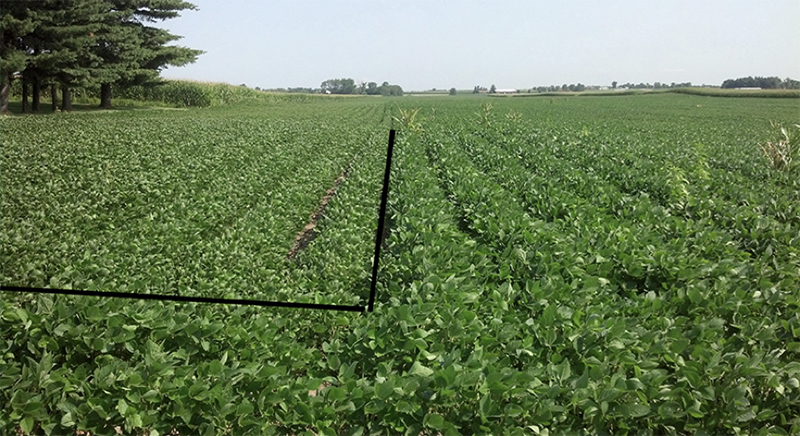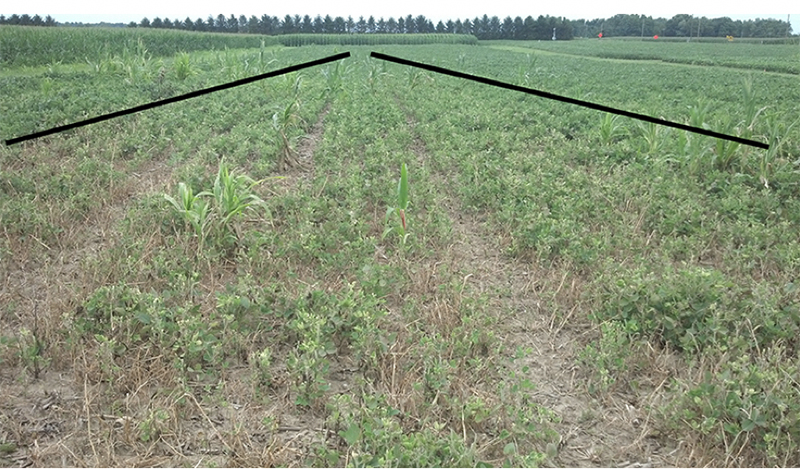Picture of the Week
May 3, 2021
Diagnosing Herbicide Injury on Field Crops
Marcelo Zimmer, Weed Science Program Specialist, Purdue University
Herbicides are extremely valuable tools in crop production. Chemical weed control is relatively cheap and more effective at reducing weed competition for water, light, and nutrients when compared to other weed management strategies (tillage, hand weeding, etc.). Herbicides will rarely cause problems on non-target plants when applied according to label recommendations. However, there are situations when herbicides are applied under less-than-ideal conditions and result in injury to non-target vegetation. Physical processes such as herbicide drift and volatilization can move the herbicide molecules from one field to another and result in crop injury.
Whenever crop injury is perceived, growers may be inclined to blame their neighbors for the injury to their crop. However, there are many situations where crop injury can occur that are related to in-field crop management practices rather than herbicide off-target movement. These situations include contaminated spray equipment; inappropriate sprayer calibration and/or faulty equipment; excessive herbicide use rates; herbicide interactions with other pesticides or the weather; herbicide carryover from the previous crops; and other abiotic or biotic stresses. Therefore, it is crucial that growers are able to recognize the patterns of crop injury development associated with each one of these processes to accurately identify the cause of injury.
Looking for signs: We can use signs or patterns in the field to help diagnose stresses to the crop. In instances of herbicide contamination in the spray equipment there are a couple of signs or symptoms that can quickly help conclude that spray equipment contamination is to blame. Sprayers make paths of straight lines up and down the field and therefore when a problem occurs the signs of the problem will also show up in these straight-line paths. Naturally occurring stresses such as nutrient deficiencies, insect damage, and plant pathogens do not occur in these neat straight lines. Being able to identify a few of these signs or patterns in the field can go a long way to helping identify the culprit. Figures 1 and 2 show how these unnatural or mechanical patterns in the field can help to diagnose sprayer contamination events.
In Figure 1 you can see that the soybeans to the left of the black line appear to be stunted and deformed as compared to soybeans to the right. In this case, the sprayer had made a single pass down the left side of this field to reach another field behind it and the operator decided he might as well spray that strip while he was driving down it. A benign decision by the operator turned into a key pattern that helped identify what had injured the soybean plants in the target field that he was traveling to. The injured soybeans were in perfect straight path that the sprayer had traveled, again a naturally occurring stress would not occur in a straight line. In the picture you can also see where the operator turned on the sprayer with differences in soybean height above and below the horizontal black line. After considering these patterns in the field as well as symptoms on individual plants, it became apparent that a herbicide had contaminated the spray tank and was causing injury to the soybeans.
 Figure 1. A pattern of stunted soybean plants in a straight line down the left side of the pictures indicate that there was a contaminate in the spray tank.
Figure 1. A pattern of stunted soybean plants in a straight line down the left side of the pictures indicate that there was a contaminate in the spray tank.
 Figure 2. Severe injury to soybeans the entire width of the sprayer where it entered the field with that injury tapering off in width and severity as the sprayer traveled into the field indicate that was a contaminate in the spray boom.
Figure 2. Severe injury to soybeans the entire width of the sprayer where it entered the field with that injury tapering off in width and severity as the sprayer traveled into the field indicate that was a contaminate in the spray boom.
 Figure 3. In this case, dicamba drifted onto susceptible soybeans (right side) due to an off-label application over the top of dicamba-tolerant soybeans (left side) .
Figure 3. In this case, dicamba drifted onto susceptible soybeans (right side) due to an off-label application over the top of dicamba-tolerant soybeans (left side) . The symptoms on individual plants go a long way towards indicating if a herbicide contaminate injured the plant, but recognizing these mechanical patterns in the field greatly assist in confirming a drift, tank, or boom contamination event. If you notice these patterns in the field it is extremely helpful to include pictures of those patterns or even field maps with sketches of the patterns with plant samples when submitting them for diagnosis.
Herbicide carryover issues usually occur in a less clear pattern than herbicide drift or tank-contamination. Most of the time, herbicide carryover symptoms develop on sandy knolls, wet spots, soils with low organic matter content, or extreme soil pH (too high or too low). Herbicide application records for the current and previous crop, soil maps, and weather records are extremely useful for investigating herbicide carryover concerns.
Timing of exposure: Depending on the rate of exposure and weather conditions following exposure, herbicide injury symptoms will develop within 2-5 days for contact herbicides [Gramoxone (paraquat), Liberty (glufosinate), Sharpen (saflufenacil), others] and within 1-3 weeks for systemic herbicides (dicamba, 2,4-D, glyphosate, others). Within a couple of weeks after the herbicide symptoms develop, most injured crops will recover and resume growth, and accurate herbicide injury identification may not be possible at that point. Therefore, if herbicide drift is suspected, it is crucial to collect plants samples and photographic evidence (field patterns and individual plants) whenever the symptoms develop.
Find Out the Cause of Damage: Purdue Extension county educators can help you determine the cause of the injury symptoms. The educators will look for any possible explanations for the damage, including nutrient deficiencies; insect, weed, and disease problems; improper planting and cultivation practices; and environmental conditions. They may even suggest that you submit a sample to the Purdue Plant & Pest Diagnostic Laboratory where a specialist will examine the sample. To find your Purdue Extension county office call 888-EXT-INFO or go to Purdue Extension.
The Office of Indiana State Chemist (OISC) is an independent state agency that has the responsibility to investigate pesticide complaints. They investigate complaints at no cost. OISC will only determine if drift occurred and if the applicator violated the product label or Indiana Drift Rule. At the conclusion of the case both the complaining party and the applicator receive a copy of the findings. OISC does not get involved in matters of restitution or compensation for loss. If OISC determines there has been a violation, then you will need to decide if and how you wish to quantify the loss and whether to seek compensation for your loss. You can seek damages directly with the applicator, with insurance companies, or through civil proceedings. To file a complaint with OISC call 765-494-1589 or go to www.oisc.purdue.edu/pesticide/index.html and click on Filing a Pesticide or Fertilizer/Manure Complaint.
For a look at residential herbicide drift problems see Joe Becovitz and Fred Whitford's article in the Purdue Landscape Report - https://www.purduelandscapereport.org/issue/21-06/

